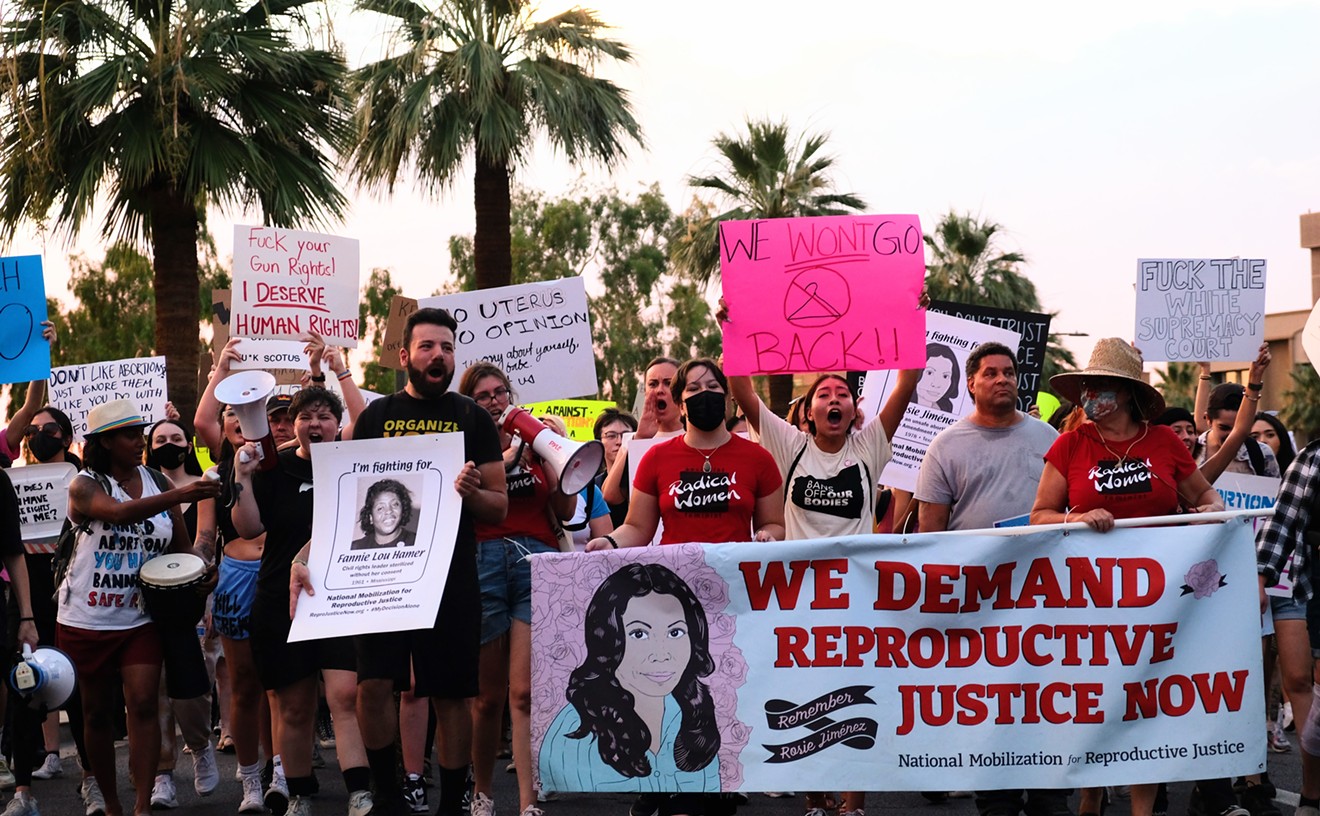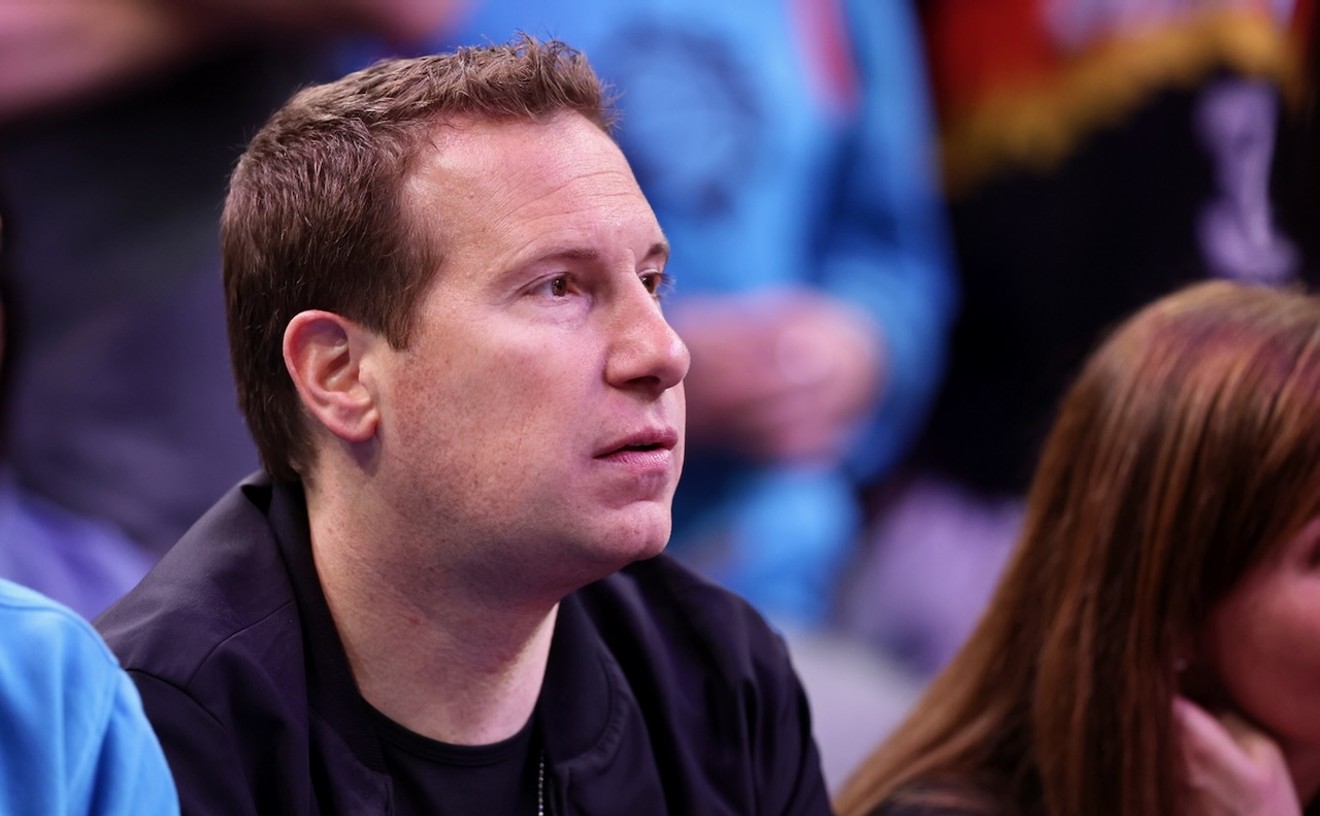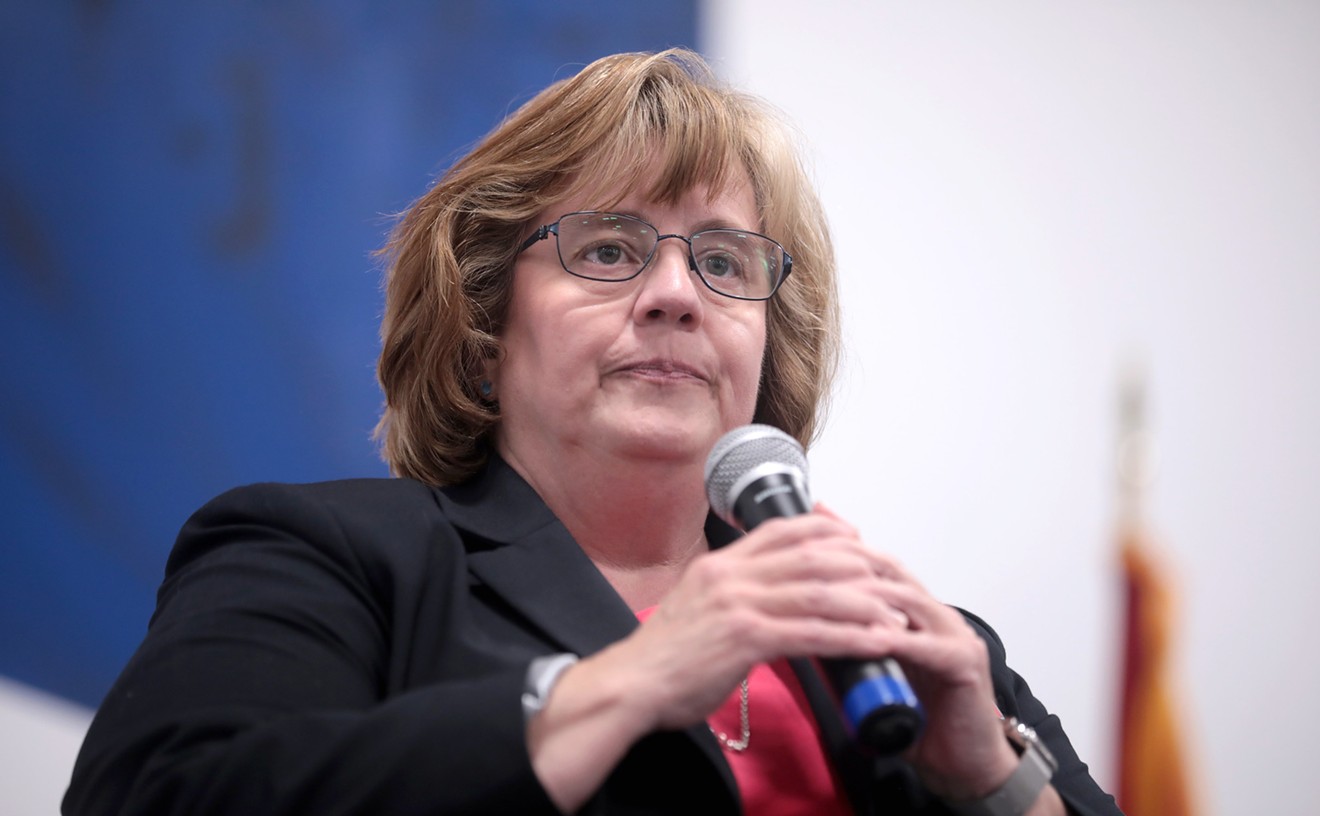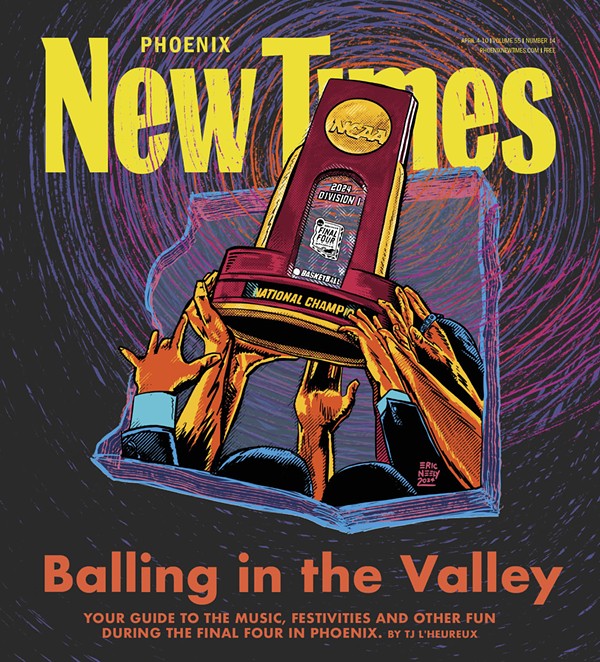Key evidence that could explain why the Granite Mountain Hotshots moved from a safe location into a treacherous box canyon where 19 men died on June 30, 2013, was in the Office of the Maricopa County Medical Examiner's possession but was not provided to a contracted state investigation into the disaster, autopsy records obtained by New Times show.
A cell phone belonging to Granite Mountain superintendent Eric Marsh and a functioning camera belonging to hotshot Christopher MacKenzie were with the men's bodies when they arrived at the Medical Examiner's Office on July 1, 2013, but were not listed as evidence turned over later to the Yavapai County Sheriff's Office.
The YCSO has no record of Marsh's phone or of MacKenzie's camera as official evidence collected from the medical examiner, according to a YCSO police report. Both items ended up in the possession of family members.
The Maricopa County medical examiner conducted autopsies on the bodies of all 19 hotshots for Yavapai County on July 2, 2013. The names of representatives from YCSO and the Arizona Forestry Division appear on the autopsy reports as in attendance on 10 of the 19 autopsies that were conducted by four different doctors.
MacKenzie’s autopsy reports states that Deputy State Forester Jerry Payne and YCSO Criminal Investigations Commander Lieutenant Tom Boelts were present. But neither name appears on Marsh’s autopsy report.
The YCSO was in charge of gathering all evidence from the medical examiner and later turning it over to the Serious Accident Investigation Team (SAIT), contracted by the Arizona Forestry Division to conduct the formal investigation into the Yarnell Hill Fire disaster.
MacKenzie’s camera included video clips of a crucial discussion between Marsh and Granite Mountain Captain Jesse Steed that suggests disagreement over tactics before the crew left the “black” burned-over area.
The reports only were recently released. Yavapai County Attorney Sheila Polk refused repeated media requests under the Arizona Public Records Law for them in the months immediately after the fire. Polk argued in August 2013 that the privacy of families of the fallen firefighters exceeded the public's right to examine the documents.
New Times obtained the reports in October. They were released four months after all litigation filed by the families of hotshots seeking $237 million in damages from the state Forestry Division and Yavapai County had been settled. The settlement also included dropping the state Division of Occupational Safety and Health’s wrongful-death case against the Forestry Division for allegedly mishandling fire-suppression efforts during the Yarnell Hill Fire.
Philip Keen, former chief medical examiner for Yavapai and Maricopa counties, said law enforcement determines what personal items accompanying bodies should be collected for evidence and what should be released to funeral homes, which then provide personal effects to relatives.
YCSO Deputy Joshua Nelson collected phones that arrived at the Medical Examiner's Office from the personal items of two other hotshots, and the phones subsequently are identified as evidence, according to autopsy records.
On July 4, three other YCSO personnel went through the personal property of each firefighter at the Medical Examiner's Office, YCSO records show.
"The only items that were separated from the personal belongings were cell phones," the report prepared by YCSO Detective J. McDormett states. "Data downloads will be attempted for the state investigators, and the phones will then be returned to the fire department and eventually the families."
YCSO Lieutenant Tom Boelts and technician John File accompanied McDormett when the phones reportedly were separated from the personal effects for each hotshot, the report states.
But Marsh's cell phone and McKenzie's still-working camera — the latter clearly important because of the photos and videos of the fire it contained — were not included in the evidence collected by the YCSO.
"If [the personal property was] released to the same deputies, then there is something fishy here," says Keen, who worked as Yavapai County chief medical examiner for 29 years and Maricopa County chief medical examiner for 14 years.
Lieutenant Boelts said he was at the Medical Examiner's Office when the autopsies were performed but that he didn’t observe the autopsies: “I was there in an administrative role.”
The YCSO police report, however, states that Boelts specifically prepared a “spreadsheet” that detailed items collected from each firefighter: “Note that Lt. Boelts created a spreadsheet articulating what personal property was located in each bag with corresponding name, YCSO number (1-19) and medical examiner case number.”
Boelts said he doesn’t know anything about what happened to Marsh’s cell phone or to MacKenzie’s camera. He wouldn't respond to Keen’s description of the cell phone and camera's becoming evidence as “fishy.”
Deputy Nelson, Boelts said, picked up all the personal belongings of the firefighters and turned them over to the Prescott Fire Department.
Mike Molzhon, administrative services manager for the Maricopa County ME, did not comment on why Marsh's phone and MacKenzie's camera did not appear as evidence.
Arizona Forestry Division spokesman Bill Boyd said the division doesn't know why the evidence wasn't forwarded to the YCSO and subsequently to the investigation team and how its omission may have affected the investigation.
"You're going to have to talk to [the Serious Accident Investigation Team]," Boyd says.
The Forestry Division signed an agreement to form the accident investigation team led by out-of-state experts on July 3, 2013. The team was charged with reviewing the conditions and events leading to the tragedy.
Jim Karels, state forester for the Florida Forest Service, led the 54-member investigation. The team visited the accident site, reviewed audio and video files, interviewed individuals associated with the incident, reviewed fire, weather, and behavior data, and examined available records and physical evidence.
Messages left with the Florida Forest Service requesting an interview with Karels were not returned.
The broken chain of custody of two key pieces of key evidence further undermines the integrity of the investigation of the worst loss of life suffered by wild-fire suppression teams (known as Interagency Hotshot Crews) since 1946, when the first such crew was formed.
"If we are aware of two things like that [the cell phone and the camera], what else is there that nobody has seen?" asks Ted Putnam, a retired federal wildfire fatality investigator who participated in the investigation of the South Canyon Fire that killed 14 firefighters in Colorado in 1994.
"The basic question in my mind is why didn't [SAIT investigators] ask for the cell-phone records?" says Dick Mangan, a retired wildfire death investigator who participated in the South Canyon investigation and in the 1990 Dude Fire in Arizona that killed six firefighters.
Mangan says if he had been conducting the Yarnell Hill Fire investigation, he would have obtained the phone records of everyone working the fire.
"Who the hell was talking to who and at what time?" he says. "[Checking] cell phone records in this day and age is basic."
Marsh's phone was with his body when it arrived at the Medical Examiner's Office on July 1, 2013, autopsy records show. The phone, however, is not listed as evidence in the autopsy report signed by. Dr. Vladimir Shvarts.
The phone eventually ended up in the possession of Marsh's widow, Amanda, according to the Prescott Courier. Amanda Marsh declined a request for an interview and has refused in the past to provide copies of Marsh's phone records from June 30, 2013.
Autopsy records for MacKenzie show a phone and a Canon camera present in the body bag that contained MacKenzie's remains. The autopsy report notes that the Canon S1400IS still was working.
The autopsy report, prepared by Dr. Christopher K. Poulos, does not include the camera or the phone under the heading "Evidence." Instead, Dr. Poulos states the evidence "includes a flame-retardant pouch, one boot, one helmet, pants with belt, two gloves, and a yellow long-sleeve shirt size large."
The YCSO report, however, includes MacKenzie's phone as evidence. But the more-important Canon camera, which included the two videos of Marsh and Steed, is not among YCSO evidence.
Instead of ending up with the YCSO, MacKenzie's Canon camera was sent to his father, Mike MacKenzie, sometime before July 13, according to a September 28, 2013, story in the Courier. Mike MacKenzie was surprised to discover it was still functioning, the paper reported.
Mike MacKenzie reportedly made a copy of photographs and videos and, during his son's funeral services, provided them to Prescott Wildlands Division Chief Darrell Willis on July 13, according to the Courier. Willis, who supervised the Granite Mountain crew and since has retired, said he gave a CD with the photos and videos to SAIT investigators.
The photos and videos do not appear in the investigators' formal 122-page Serious Accident Investigation Report (SAIR) released to the families and public on September 28, 2013. Instead, they are among thousands of pages of supporting documents released to the media in December 2013.
The SAIR does not mention the two videos that may show a disagreement between Marsh and Steed. The two nine-second videos were taken about 4 p.m. on June 30.
"I was just saying, I knew this was coming when I called you and asked what your comfort level was," Marsh says to Steed in the first short video. "I could just feel it, you know."
The second clip begins with Marsh ending a sentence with "...saying you know [unintelligible]." Steed replies, "I copy, and [the fire's] almost made it to that two-track road that we walked in on." Steed replies in the second video, "I copy, and [the fire] almost made it to that two-track road that we walked in on."
Brendan McDonough, sole surviving Granite Mountain Hotshot, reportedly told Willis last year that there was a heated disagreement between Steed and Marsh about moving the crew. Willis informed Prescott town attorney Jon Paladini about what McDonough said, according to a story in the Arizona Republic. Steed did not want the crew to leave its safe zone but subsequently relented to Marsh's order, according to the account provided by Paladini.
McDonough later denied saying what Paladini told the paper. McDonough, however, never has provided sworn testimony about what he heard over the crew's radio channel in the moments leading up to the deaths.
The state-contracted SAI report concluded that no one did anything wrong, despite the fact that 19 men died in a box canyon. Wild-land firefighters know that such canyons are death traps. The report states that there was lack of communication between Granite Mountain and fire supervisors in the 33 minutes leading up to their desperate call for help at about 4:37 p.m.
"There is much that cannot be known about the crew's decisions and actions prior to their entrapment and fire shelter deployment around (4:42 p.m.)," the report states.
The report also states that investigators had "no indication that anyone asked them to move and does not know for certain why they moved."
New Times filed a request for the autopsy reports under the Arizona Public Records Law in October, more than two years after Polk refused to release the autopsy records, citing privacy concerns.
"Therefore, absent a court order, these items will not be released," Polk stated in an August 26, 2013, letter sent to news organizations.
By the time the autopsy reports were released, 12 of 13 wrongful-death lawsuits filed by the families of the deceased hotshots against the state Forestry Division, the city of Prescott, and the Central Yavapai (County) Fire District had been settled. A court dismissed the 13th suit last summer. The settlement called for the 12 families to each receive $50,000 and for the seven others to each get $10,000.
The state Forestry Division admitted no wrongdoing.










